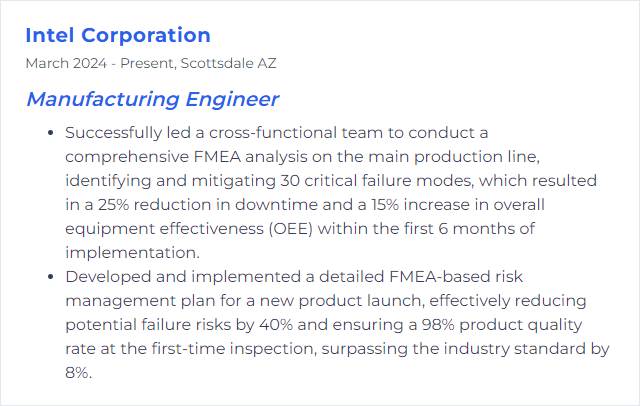Top 12 Manufacturing Engineer Skills to Put on Your Resume
In today's job market, a manufacturing engineer is judged fast on skills that sharpen throughput, cut waste, and make complex systems hum. Listing the right capabilities on your resume isn’t fluff; it’s proof you can design smart, fix bottlenecks, and elevate productivity across the floor.
Manufacturing Engineer Skills
- AutoCAD
- SolidWorks
- Lean Manufacturing
- Six Sigma
- PLC Programming
- Robotics
- CNC Machining
- Kaizen
- 3D Printing
- Minitab
- ISO Standards
- FMEA Analysis
1. AutoCAD
AutoCAD is CAD software used to create precise 2D drawings and 3D models of parts and assemblies, enabling design, visualization, and verification before anything hits the line.
Why It's Important
It lets Manufacturing Engineers iterate quickly, control tolerances, and translate ideas into buildable geometry. Fewer surprises. Faster changes. Cleaner handoffs to production.
How to Improve AutoCAD Skills
Leveling up means pushing beyond drafting into smarter workflows.
Shift to 3D where it counts: Model parts and fixtures in 3D to catch clashes, stack-ups, and assembly issues early.
Automate the repetitive: Learn AutoLISP or scripts to batch-edit layers, title blocks, or attribute data. Minutes saved add up fast.
Exploit data extraction: Pull BOMs, hole tables, and metadata straight out of drawings to reduce manual errors.
Use web/mobile access for reviews: Share, mark up, and approve drawings without waiting on email chains.
Create robust templates: Company standards, layers, dimension styles, and blocks—pack them into templates so every drawing starts right.
Practice version discipline: Naming, revision blocks, and change notes that make traceability obvious.
Do these and your drawings move smoother through design, purchasing, and the shop.
How to Display AutoCAD Skills on Your Resume
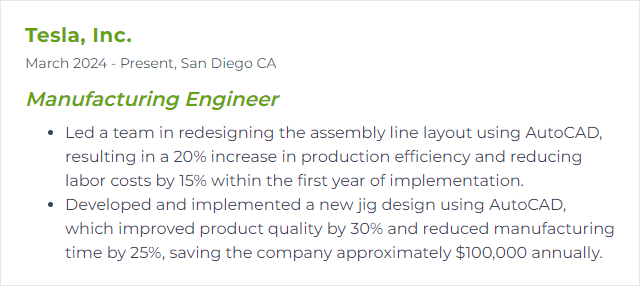
2. SolidWorks
SolidWorks is 3D CAD/CAE for building parts, assemblies, and drawings—with tools for simulation, sheet metal, weldments, surfacing, and more.
Why It's Important
It compresses design cycles, visualizes fit and function, and validates ideas with simulation so you catch issues before they cost real money.
How to Improve SolidWorks Skills
Make the software work for you, not the other way around.
Master fundamentals: Sketch relations, design intent, configurations, mates, and robust feature ordering.
Go deep on manufacturing features: Sheet metal, weldments, molds, CAM workflows—whichever your shop needs most.
Use Simulation: Quick checks on stiffness, interference, fatigue, and thermal performance to reduce prototype spins.
Customize your workspace: Keyboard shortcuts, macros, and custom toolbars shave hours per week.
Tidy data management: Clear naming, revision rules, and references so assemblies don’t break on you.
Practice design for manufacturability: Draft, tolerances, radius standards, and fixture-friendly features.
Portfolio pieces that show complex assemblies and released drawings speak volumes.
How to Display SolidWorks Skills on Your Resume
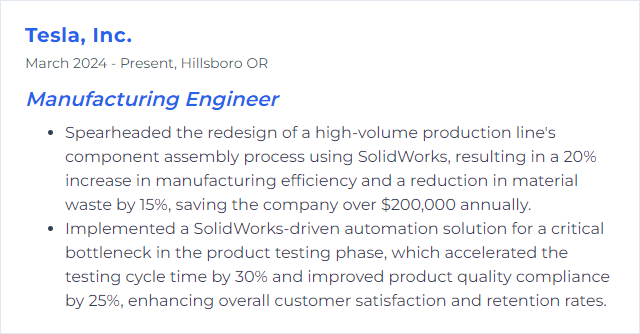
3. Lean Manufacturing
A methodical approach to squeeze out waste and raise flow, quality, and responsiveness. It’s about value, not just velocity.
Why It's Important
Lean trims cost, shortens lead time, and boosts customer satisfaction. Waste down, throughput up.
How to Improve Lean Manufacturing Skills
Don’t hunt waste blindly—map it, measure it, and remove it.
Value Stream Map: Expose waits, rework, and excess WIP. Target the constraints.
Kaizen cadence: Small, relentless improvements beat big, rare initiatives.
5S the workspace: Order, cleanliness, and visual controls reduce motion, errors, and time loss.
Jidoka: Build in quality—stop the line on defects and fix causes, not symptoms.
Just-In-Time: Pull systems, takt-time alignment, and smaller batches to smooth flow.
Root cause rigor: 5 Whys, fishbone diagrams, and verified countermeasures.
Standard work: Clear, current SOPs with audits to hold the gains.
Cross-train: Flexible teams that flex with demand.
How to Display Lean Manufacturing Skills on Your Resume

4. Six Sigma
A data-driven method to reduce variation and defects using DMAIC and statistical tools.
Why It's Important
It turns noisy processes into predictable ones, improving quality, yield, and customer trust while slicing scrap and rework.
How to Improve Six Sigma Skills
Think in numbers; act on facts.
Deepen DMAIC: Tight problem statements, measurable CTQs, solid baselines, and verified control plans.
Use the right tools: Control charts, capability studies, hypothesis tests, DOE. Choose based on data type and goal.
Blend with Lean: Pair waste removal with variation reduction for durable gains.
Pursue certification: Green/Black Belt-level projects with real savings and verified results.
Show repeatability: Close projects with sustained metrics, not one-off wins.
How to Display Six Sigma Skills on Your Resume
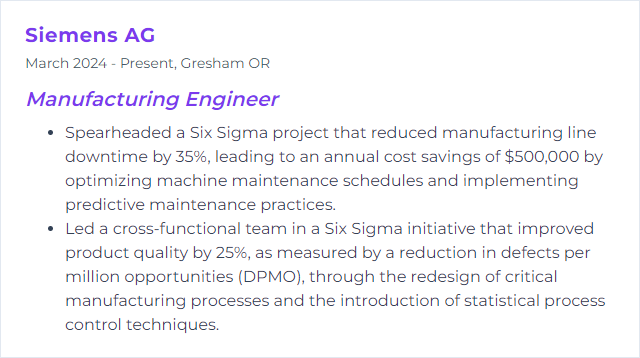
5. PLC Programming
Programming industrial controllers to automate equipment and lines using IEC 61131-3 languages like ladder logic, function block, and structured text.
Why It's Important
Automation runs the modern plant. PLCs deliver consistent, safe control with rapid changeover and diagnostics.
How to Improve PLC Programming Skills
Code like the next person maintaining it is your future self on a tight deadline.
Strengthen fundamentals: I/O mapping, P&IDs, electrical schematics, and safety circuits.
Modular architecture: Functions and function blocks with clear interfaces. Reuse pays dividends.
State machines: Deterministic sequences, interlocks, and fault handling that are easy to trace.
Readable code: Naming standards, comments that explain intent, and version control.
Simulation and emulation: Test before you touch the line. Fewer surprises on startup.
HMI/SCADA integration: Alarms, trends, and diagnostics that actually help operators.
Commissioning discipline: FAT/SAT checklists, I/O validation, and change logs.
How to Display PLC Programming Skills on Your Resume
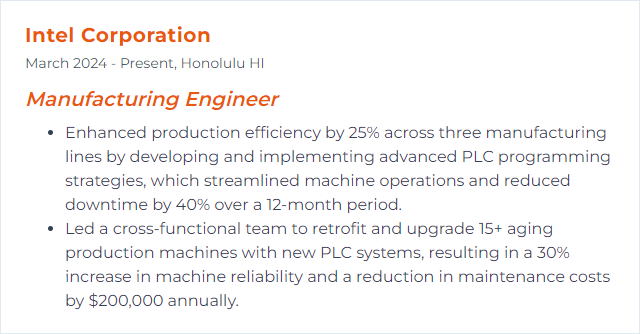
6. Robotics
Designing, programming, and deploying robots to automate tasks—material handling, welding, assembly, inspection—with precision and safety.
Why It's Important
Robotics raises throughput, reduces ergonomic risk, and keeps quality steady even on long shifts.
How to Improve Robotics Skills
Think system, not just arm.
Cell design first: Tooling, reach studies, cycle-time balance, and safe zones before programming.
Offline programming: Build, simulate, and optimize paths without halting production.
Use smarter sensing: Vision, force/torque, and proximity for adaptable tasks.
Standardize routines: Pick/place templates, error recovery, and homing sequences reused across cells.
Collaborative options: Cobots for mixed human-robot workflows where full guarding isn’t feasible.
Plan maintenance: Wear parts, lubrication, and backup/restore procedures locked in.
How to Display Robotics Skills on Your Resume
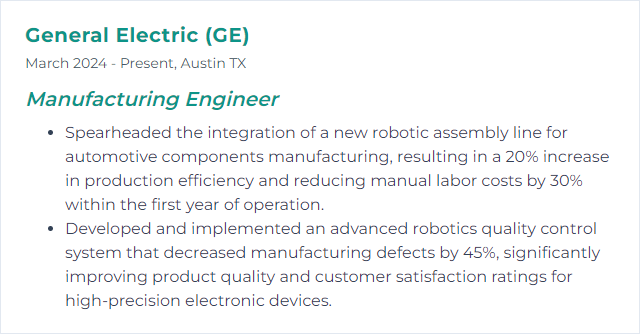
7. CNC Machining
Computer-controlled milling, turning, drilling, and more to produce tight-tolerance parts with repeatability.
Why It's Important
It delivers precision at scale, enabling complex geometries and consistent quality with competitive cycle times.
How to Improve CNC Machining Skills
Shave seconds, guard microns.
Right tools, right params: Tool material, coatings, speeds/feeds, stepovers—dialed to the workpiece.
CAM optimization: Efficient toolpaths, rest machining, adaptive clearing, and minimized air cuts.
Setup reduction: Quick-change fixturing, standardized workholding, and probing for fast zeroing.
Preventive maintenance: Keep spindles, ways, and coolant healthy to protect accuracy.
In-process inspection: Probing, SPC checks, and feedback loops to correct drift immediately.
Explore capability: 5-axis strategies, high-speed machining, and balanced tool libraries.
Train continuously: Programmers and operators learning together—fewer handoff losses.
How to Display CNC Machining Skills on Your Resume
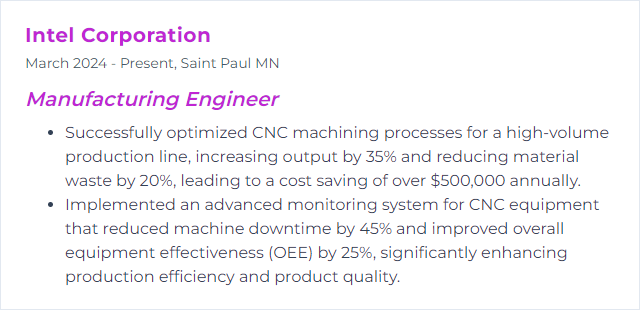
8. Kaizen
Continuous, incremental improvement. Everyone, every day, everywhere in the process.
Why It's Important
It nurtures a culture where problems surface early, fixes stick, and performance edges upward without drama.
How to Improve Kaizen Skills
Make improvement normal, not exceptional.
Train the team: Teach basic tools, from 5S to A3 thinking, so ideas translate into action.
Standardize first: Document current best way, then improve from a stable baseline.
Visual management: KPIs, boards, and andon signals that expose gaps at a glance.
Short cycles: Rapid experiments with before/after data and clear owners.
Celebrate wins: Recognize contributors and share learnings to fuel the next round.
Measure impact: Safety, quality, delivery, cost—track and review.
How to Display Kaizen Skills on Your Resume
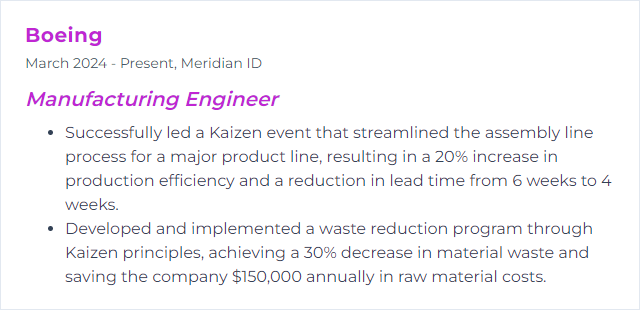
9. 3D Printing
Additive manufacturing that builds parts layer by layer from digital models, ideal for rapid prototypes, complex internal channels, and short-run custom parts.
Why It's Important
It compresses development time, slashes tooling costs, and unlocks geometries impossible with subtractive processes.
How to Improve 3D Printing Skills
Treat it like a process, not a magic box.
Pick the right process/material: FDM, SLA, SLS, MJF, DMLS—match properties, tolerances, and cost to the job.
Calibrate routinely: Bed leveling, extrusion flow, laser power—tight control equals dimensional truth.
Design for additive: Optimize orientation, supports, lattice structures, and wall thickness for strength and speed.
Use simulation and slicing wisely: Predict warpage, shrink, and thermal issues before you press start.
Post-process with intent: Heat treatment, machining, vapor smoothing, or dyeing for functional and cosmetic needs.
Quality checks: First-article inspection and periodic audits to keep variability in check.
How to Display 3D Printing Skills on Your Resume
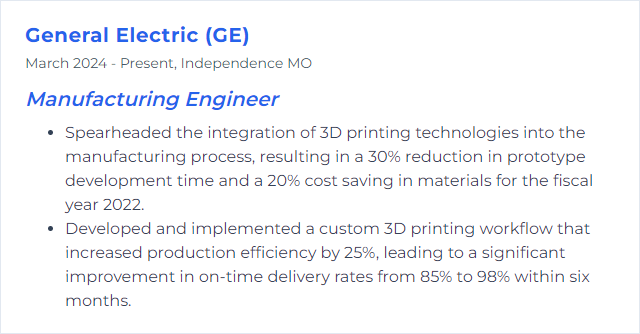
10. Minitab
Minitab is statistical software used to analyze data, visualize variation, and drive decisions in quality and process improvement.
Why It's Important
It turns raw shop-floor data into insight—capability indices, control charts, regressions—that guide real fixes.
How to Improve Minitab Skills
Build statistical muscle, not just button clicks.
Own the basics: Data types, distributions, descriptive stats, and clean data entry.
Control charts and capability: Choose the correct chart, interpret signals, and quantify Cp/Cpk with confidence.
Hypothesis testing: t-tests, ANOVA, chi-square—pose questions, test assumptions, act on results.
DOE: Plan factorial and response surface experiments to find the levers that matter.
Templates and macros: Standardize recurring analyses for speed and consistency.
Story with visuals: Clear graphs and summaries that non-statisticians grasp instantly.
How to Display Minitab Skills on Your Resume
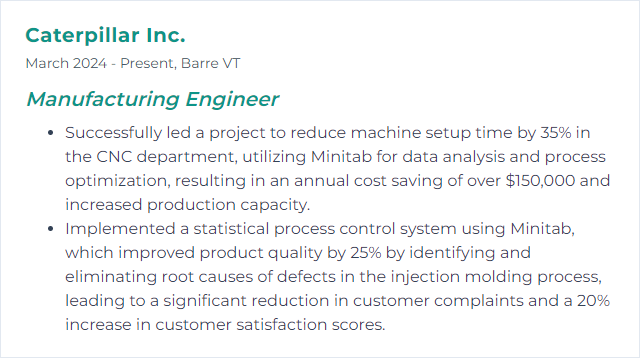
11. ISO Standards
International frameworks that define how quality, safety, and environmental systems are built and audited. Common in manufacturing: ISO 9001, 14001, 45001, 13485, and IATF 16949.
Why It's Important
Standards anchor consistency. They shorten audits, smooth supplier/customer alignment, and keep compliance tight.
How to Improve ISO Standards Skills
Make the system breathe with the business.
Know the clauses: Understand requirements that apply to your processes and evidence needed.
Run a gap analysis: Compare current practice to standard requirements; prioritize fixes with owners and deadlines.
Document what matters: Lean procedures, version control, and records that prove conformance without bloat.
KPIs that matter: Set measurable objectives and review them during management reviews.
Internal audits: Risk-based audit plans, candid findings, and verified corrective actions.
Integrate CI: Tie nonconformances to root cause, CAPA, and ongoing continuous improvement.
Train roles: Auditors, process owners, and operators who know their responsibilities.
How to Display ISO Standards Skills on Your Resume
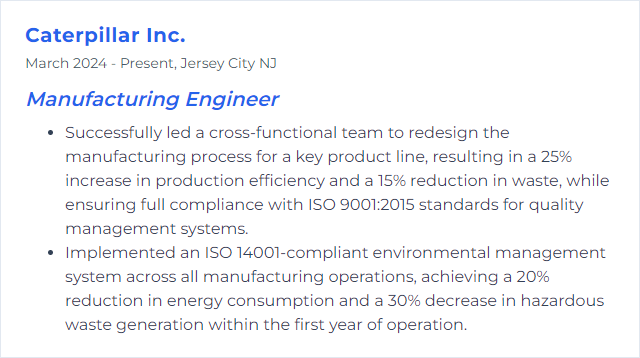
12. FMEA Analysis
FMEA (Failure Modes and Effects Analysis) identifies how a process or product can fail, estimates risk, and drives preventive actions before defects reach the customer.
Why It's Important
It spotlights fragile steps, reduces downtime, and protects quality. Problems predicted are problems prevented.
How to Improve FMEA Analysis Skills
Sharper FMEAs mean fewer surprises.
Cross-functional teams: Bring design, manufacturing, quality, maintenance, and supply chain to the table.
Use current data: Field returns, scrap codes, downtime logs—feed reality into severity, occurrence, and detection ratings.
Adopt harmonized methods: Apply AIAG-VDA practices with Action Priority (AP) to focus on what truly needs action.
Trace to controls: Link causes to prevention/detection controls and verify they actually work.
Own the actions: Clear owners, due dates, verification of effectiveness, and updates to the FMEA.
Keep it live: Revise after design changes, process shifts, new suppliers, or quality escapes.
How to Display FMEA Analysis Skills on Your Resume
